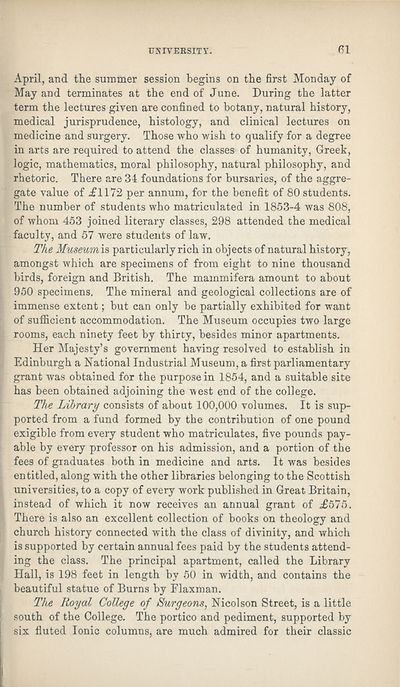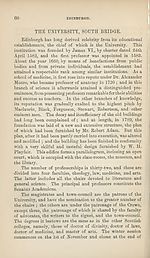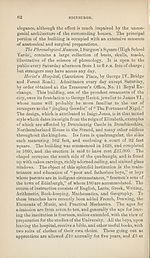Download files
Complete book:
Individual page:
Thumbnail gallery: Grid view | List view

UNIVERSITY.
(51
April, and the summer session begins on the first Monday of
May and terminates at the end of June. During the latter
term the lectures given are confined to botany, natural history,
medical jurisprudence, histology, and clinical lectures on
, medicine and surgery. Those who wish to qualify for a degree
in arts are required to attend the classes of humanity, Greek,
logic, mathematics, moral philosophy, natural philosophy, and
’ rhetoric. There are 34 foundations for bursaries, of the aggre¬
gate value of i‘1172 per annum, for the benefit of 80 students.
The number of students who matriculated in 1853-4 was 808,
of whom 453 joined literary classes, 298 attended the medical
faculty, and 57 were students of law.
The Museurais, particularly rich in objects of natural history,
amongst which are specimens of from eight to nine thousand
birds, foreign and British. The mammifera amount to about
950 specimens. The mineral and geological collections are of
immense extent; but can only be partially exhibited for want
I of sufficient accommodation. The Museum occupies two large
rooms, each ninety feet by thirty, besides minor apartments.
Her Majesty’s government having resolved to establish in
Edinburgh a National Industrial Museum, a first parliamentary
grant was obtained for the purpose in 1854, and a suitable site
has been obtained adjoining the west end of the college.
The Library consists of about 100,000 volumes. It is sup¬
ported from a fund formed by the contribution of one pound
i exigible from every student who matriculates, five pounds pay-
[ able by every professor on his admission, and a portion of the
fees of graduates both in medicine and arts. It was besides
entitled, along with the other libraries belonging to the Scottish
universities, to a copy of every work published in Great Britain,
instead of which it now receives an annual grant of £575.
There is also an excellent collection of books on theology and
church history connected with the class of divinity, and which
j is supported by certain annual fees paid by the students attend¬
ing the class. The principal apartment, called the Library
Hall, is 198 feet in length by 50 in width, and contains the
beautiful statue of Burns by Flaxman.
The Royal College of Surgeons, Nicolson Street, is a little
south of the College. The portico and pediment, supported by
six fluted Ionic columns, are much admired for their classic
(51
April, and the summer session begins on the first Monday of
May and terminates at the end of June. During the latter
term the lectures given are confined to botany, natural history,
medical jurisprudence, histology, and clinical lectures on
, medicine and surgery. Those who wish to qualify for a degree
in arts are required to attend the classes of humanity, Greek,
logic, mathematics, moral philosophy, natural philosophy, and
’ rhetoric. There are 34 foundations for bursaries, of the aggre¬
gate value of i‘1172 per annum, for the benefit of 80 students.
The number of students who matriculated in 1853-4 was 808,
of whom 453 joined literary classes, 298 attended the medical
faculty, and 57 were students of law.
The Museurais, particularly rich in objects of natural history,
amongst which are specimens of from eight to nine thousand
birds, foreign and British. The mammifera amount to about
950 specimens. The mineral and geological collections are of
immense extent; but can only be partially exhibited for want
I of sufficient accommodation. The Museum occupies two large
rooms, each ninety feet by thirty, besides minor apartments.
Her Majesty’s government having resolved to establish in
Edinburgh a National Industrial Museum, a first parliamentary
grant was obtained for the purpose in 1854, and a suitable site
has been obtained adjoining the west end of the college.
The Library consists of about 100,000 volumes. It is sup¬
ported from a fund formed by the contribution of one pound
i exigible from every student who matriculates, five pounds pay-
[ able by every professor on his admission, and a portion of the
fees of graduates both in medicine and arts. It was besides
entitled, along with the other libraries belonging to the Scottish
universities, to a copy of every work published in Great Britain,
instead of which it now receives an annual grant of £575.
There is also an excellent collection of books on theology and
church history connected with the class of divinity, and which
j is supported by certain annual fees paid by the students attend¬
ing the class. The principal apartment, called the Library
Hall, is 198 feet in length by 50 in width, and contains the
beautiful statue of Burns by Flaxman.
The Royal College of Surgeons, Nicolson Street, is a little
south of the College. The portico and pediment, supported by
six fluted Ionic columns, are much admired for their classic
Set display mode to:
![]() Universal Viewer |
Universal Viewer | ![]() Mirador |
Large image | Transcription
Mirador |
Large image | Transcription
| Antiquarian books of Scotland > Scotland/Scots > Black's picturesque tourist of Scotland > (113) |
|---|
| Permanent URL | https://digital.nls.uk/130029546 |
|---|
| Description | Thousands of printed books from the Antiquarian Books of Scotland collection which dates from 1641 to the 1980s. The collection consists of 14,800 books which were published in Scotland or have a Scottish connection, e.g. through the author, printer or owner. Subjects covered include sport, education, diseases, adventure, occupations, Jacobites, politics and religion. Among the 29 languages represented are English, Gaelic, Italian, French, Russian and Swedish. |
|---|

